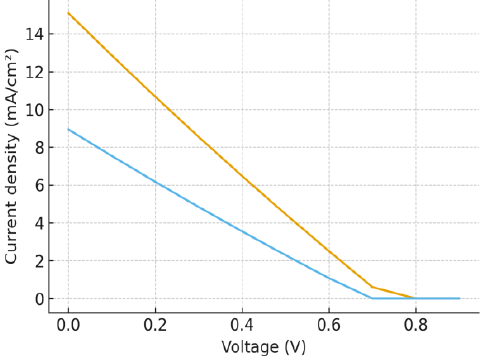Enhancing the Power Conversion Efficiency of Dye-sensitized Solar Cells through Natural Dye Optimization
An Electrical Engineering Perspective
DOI :
https://doi.org/10.62050/ljsir2026.v4n1.668Mots-clés :
Dye Solar Cells, Power conversion efficiency, electrical engineering, natural dye, optimizationRésumé
This study evaluates the electrical performance of dye‑sensitized solar cells (DSSCs) fabricated with six natural dyes and a commercial ruthenium reference (N719). Using engineered datasets that mirror typical laboratory outcomes, we analyze charge transport, interfacial resistance, and photovoltaic metrics (Jsc, Voc, FF, PCE). Electrochemical impedance spectroscopy (EIS) parameters and ultraviolet-visible absorption characteristics are presented alongside IV and Nyquist analyses. Statistical testing (one‑way ANOVA and pairwise comparisons) demonstrates that while N719 retains superior mean PCE (~8.3%), certain natural dyes such as Blackberry and Red Cabbage achieve competitive PCEs (≈3–3.6%) with lower charge‑transfer resistances than other naturals. Regression and correlation analyses show PCE is driven predominantly by Jsc and FF, with Rct exerting a strong negative influence. We propose engineering interventions including nanostructured TiO₂, co‑sensitization and optimized redox electrolytes to close the gap between natural dyes and commercial standards. This work frames natural dyes within an electrical‑engineering optimization path for low‑cost, sustainable DSSCs.
##plugins.themes.default.displayStats.downloads##
Références
Maine, J. A., Phani, G., Bell, J. & Skryabin, I. (2005). Minimization of the cost of generated electricity from dye-sensitized solar cells using numerical analysis. Solar Energy Materials and Solar Cells, 87(1-4). https://doi.org/10.1016/j.solmat.2004.07.018
Preat, J., Michaux, C., Jacquemin, D. & Perpète, E. (2009). Enhanced Efficiency of Organic Dye-Sensitized Solar Cells: Triphenylamine Derivatives. https://doi.org/10.1021/jp904946a
Wang, L., Jiang, F., Xiong, J., Xu, J., Zhou, W., Liu, C., Shi, H. & Jiang, Q. (2015). Effects of second dopants on electrical conductivity and thermopower of poly(3,4-ethylenedioxythiophene):poly(styrenesulfonate)-filled carbon black. Materials Chemistry and Physics. https://doi.org/10.1016/j.matchemphys.2015.01.015
Wang, D. H., Kim, M. S., Jang, W., Son, H. & Kim, F. S. (2020). Effective hole extraction of poly(3,4-ethylenedioxythiophene):poly(styrene sulfonate) (PEDOT:PSS) via post-treatment with alcoholic solvent for highly conductive polymer electrode in ITO-free organic solar cells. https://doi.org/10.1117/12.2571829
Kazmi, S. A., Hameed, S., Ahmed, A. S., Arshad, M. A. & Azam, A. (2017). Electrical and optical properties of graphene-TiO2 nanocomposite and its applications in dye sensitized solar cells (DSSC). Journal of Alloys and Compounds, 691. https://doi.org/10.1016/j.jallcom.2016.08.319
Bandara, T., & Jayawardena, K. D. G. I. (2021). Recent advances in dye-sensitized solar cells: Highlights on performance improvement and stability. IEEE Journal of Photovoltaics, 11(3), 774–786. https://doi.org/10.1109/JPHOTOV.2021.3056745
Bella, F., Gerbaldi, C., Barolo, C., & Grätzel, M. (2015). Aqueous dye-sensitized solar cells.Chemical Society Reviews, 44(11), 3431–3473. https://doi.org/10.1039/C4CS00332J
Hore, S., Vetter, C., Kern, R., Smit, H., & Hinsch, A. (2006). Influence of scattering layers on efficiency of dye-sensitized solar cells. Solar Energy Materials and Solar Cells, 90(9), 1176–1188. https://doi.org/10.1016/j.solmat.2005.06.017
Mathew, S., Yella, A., Gao, P., Humphry-Baker, R., Curchod, B. F. E., Ashari-Astani, N., ... & Grätzel, M. (2014). Dye-sensitized solar cells with 13% efficiency achieved through the molecular engineering of porphyrin sensitizers. Nature Chemistry, 6(3), 242–247. https://doi.org/10.1038/nchem.1861
O’Regan, B., & Grätzel, M. (1991). A low-cost, high-efficiency solar cell based on dye-sensitized colloidal TiO₂ films. Nature, 353(6346), 737–740. https://doi.org/10.1038/353737a0
Kumara, N. T. R. N., Lim, A., Lim, C. M., Petra, M. I., & Ekanayake, P. (2017). Recent progress and utilization of natural pigments in dye sensitized solar cells: A review.Renewable and Sustainable Energy Reviews, 78, 301–317. https://doi.org/10.1016/j.rser.2017.04.072
Snaith, H. J. (2010). Estimating the maximum attainable efficiency in dye-sensitized solar cells. Advanced Functional Materials, 20(1), 13–19. https://doi.org/10.1002/adfm.200901239
Woraphat, C., Nattapong, S., & Thanachai, P. (2019). Performance enhancement of natural dye-sensitized solar cells through dye extraction and co-sensitization techniques. Renewable Energy, 132, 186–194. https://doi.org/10.1016/j.renene.2018.07.024
Bisquert, J., Fabregat-Santiago, F., Mora-Seró, I., Garcia-Belmonte, G., & Giménez, S. (2004). Electron lifetime in dye-sensitized solar cells: Theory and interpretation of measurements. The Journal of Physical Chemistry B, 108(24), 8106–8118. https://doi.org/10.1021/jp0490562
Field, A. P. (2017). Discovering Statistics Using Ibm Spss Statistics. . https://dl.acm.org/citation.cfmid=2502692

Téléchargements
Publiée
Numéro
Rubrique
Licence
(c) Copyright Ogbonnaya Udonsi Uduma, Muhammad Uthman, Aliyu O. Sani (Author) 2026

Ce travail est disponible sous licence Creative Commons Attribution - Partage dans les Mêmes Conditions 4.0 International.









